Drying herbs might seem simple, but how to dry herbs with success can be more complex. If you’ve made the effort to harvest or wildcraft your herbs, the last thing you want is for them to go to waste because they weren’t properly dried. I’m going to show you some of the most important tricks that I’ve learned over time to successfully dry herbs.
I remember one time early on in my herbal journey, I gathered a whole bunch of plantain. I harvested it really carefully and laid it out to dry. I put it in a jar and was so excited. Then I came back two weeks later to make tea, and the herbs were moldy. I thought, “That’s not going to happen again!” So I got really good at drying herbs. Check out the video to learn my top tips.
3 Things to Consider When Drying Herbs
You might be wondering, should I dry my herbs in a basket, hang them, or use a dehydrator? But first, there are three important things you need to consider before you decide how to dry herbs. Once you figure out these things, then you can choose your herb drying method.
1. What’s your environmental climate?
The first thing to consider is your environmental climate. Where do you live? What time of year is it?
Do you live in Arizona? Do you live in San Francisco? Do you live in the South? What’s the climate like?
A dry, hot place is going to be much different from a cold, moist place, for instance.
2. What’s your household climate?
The second thing you want to consider is your household climate. Think about whether your house is hot, cold, dry, damp, or humid.
Another thing that really contributes to your household climate is blowing air, either hot or cold. It could be from a heater, a fan, or anything that blows in your house. Blowing air is going to make your household climate much drier.
The other thing is how many sunny windows do you have? That will increase the temperature.
3. What herb are you drying?
The third consideration is what herb are you drying? What is the water content; is it a dry or wet herb? For example, sage is a very dry herb, while comfrey or marshmallow leaves are really moist herbs.
The time of day or time of year that you harvest the herb might also affect its moistness or dryness. If you harvest herbs in early spring, you’re going deal with a higher moisture content than something that you harvest in the late fall.
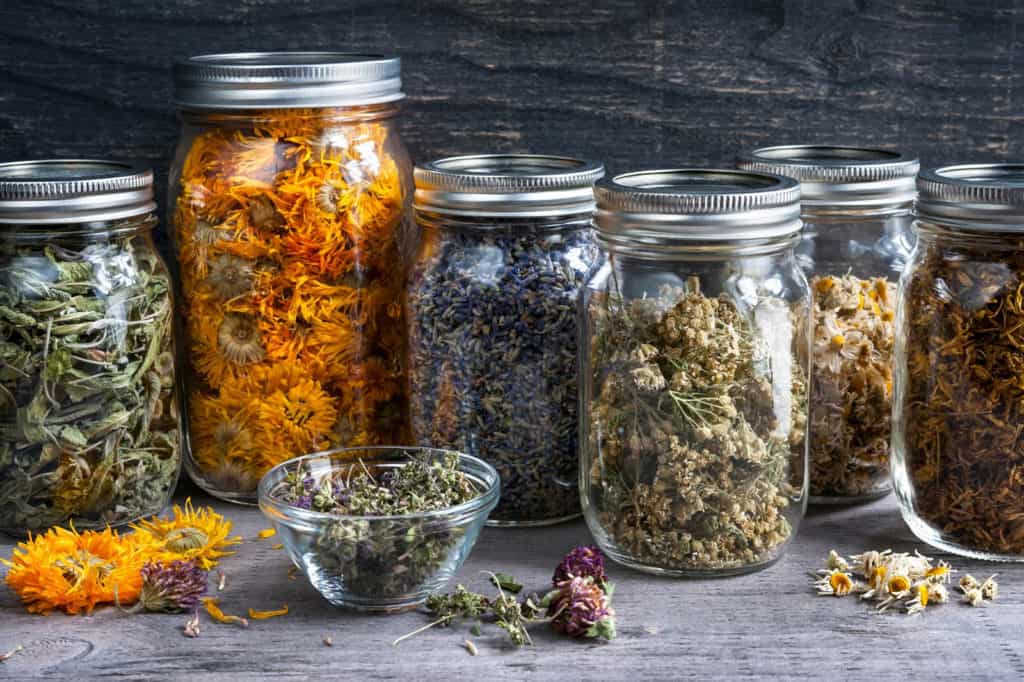
3 Ways to Dry Herbs
As you can see, every herb is different and every situation is different. Now that you’ve figured out the three things above, you can decide which herb drying method you want to use.
1. Basket Method
If you live in a dry climate, one way to dry herbs is in a basket. You want to use baskets with holes in them so there’s air circulation. I get most of my baskets at the thrift store. You can also get or make a screen and dry herbs on that.
How you do your basket method depends on where you live. I was raised in the Sacramento Valley in California where it’s hot and dry all the time in the summer. I could harvest pretty much any herb and just throw it on a basket, not pay any attention to how I laid it out, and two or three hours later it would be dry.
You may not live in such a hot and dry climate. If you live in a moderately dry climate, instead of just throwing the herbs on the basket, you want to lay them on the basket carefully. Keep the herbs separated because mold can grow if they touch each other.
Make sure that you do not put the basket in direct sunlight or blowing air. Direct sun will remove all the constituents out of your plants. Put the basket on a counter out of direct sun and blowing air, and let the herbs dry.
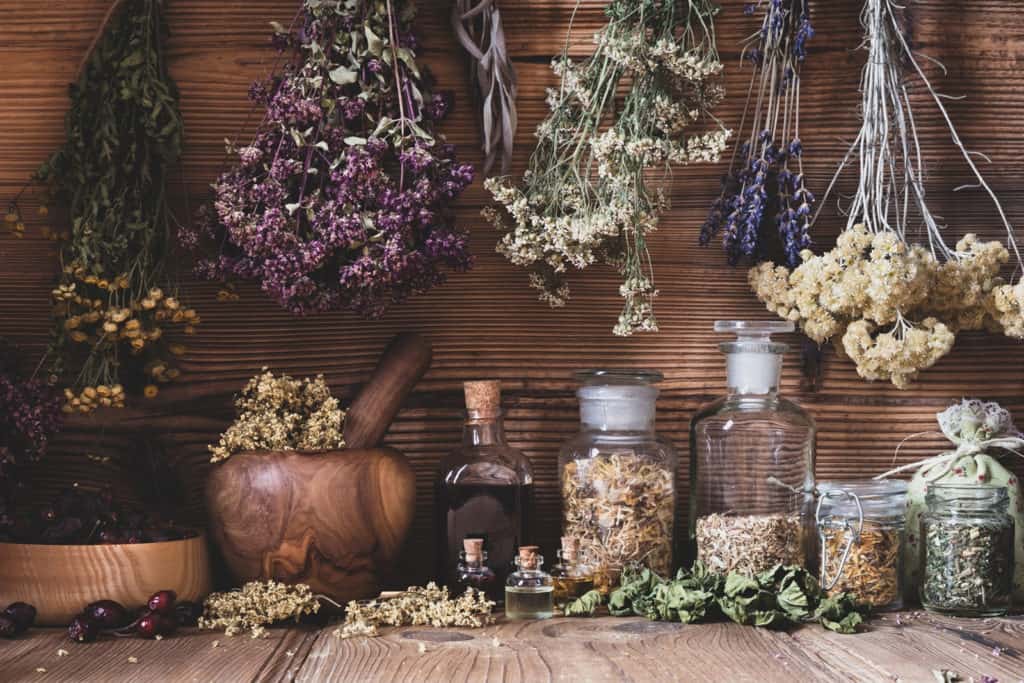
2. Hanging Method
If you have more moist climate, hanging the herbs can be a better method than the basket. Perhaps you live in a dry climate, but it’s winter so there’s moisture. Or maybe you live in a more humid area like I do by the coast, or your house is damp.
What you want to do is get a string and loop it around the herb stem. (Watch the video above for a demonstration.) You can then hang the herbs around your house somewhere up high because heat rises. I have a baseboard in my kitchen that has little nails all along it and I just hang everything up on that.
As the herbs are hanging, make sure they are exposed to air all the way around. Again, you don’t want this in direct sunlight.
If you’re dealing with a really moist plant, such as comfrey, if a tiny bit of the leaf folds over on itself, the place where it folds will turn black. You don’t want that. Comfrey leaf is one of those herbs where you want to hang up individual leaves, let them dry, and don’t let anything touch them.
Some of you may live in a climate that’s damp off and on. For example, when I lived in San Francisco, we’d have some great dry days, but then the fog would come in and it would be just wet as can be. I would have herbs hanging that were completely dry and ready to be put in a jar—and if I left them out during those moist days, they would rehydrate. If you live in one of these kind of areas, you really have to make sure that the herbs are still dry when you get them into the jar,
3. Dehydrator Method
If you find that your climate fluctuates too much between moist and dry and your herbs get moldy, or maybe they never dry in your humid climate, that’s when you get a dehydrator.
There are many types of dehydrators. I have an Excalibur, which I like because I can really lay things out and control the temperature. You want to get a dehydrator that lets you control the temperature so you can dry herbs at 100°F or lower.

How Long Does It Take to Dry Herbs?
As far as how long it takes herbs to dry, there is no single answer because all of these factors that we’ve talked about play a role. You can put an herb in a basket and it will be dry in two hours in one location and yet it will never dry in another location.
Drying herbs successfully is about using our senses and paying attention to our harvest. What’s happening with this herb? Is it dry? Has it just rehydrated?
I have people ask, “How do I know when an herb is dry?” You know it’s dry when it’s crunchy and crackly. You can hear it. There’s no moisture. If you don’t know what that feels like yet, this is an opportunity to tune into nature, redevelop your senses, and learn herb by herb.
I would love to hear from you! Have you ever dried your own herbs? What are some of the things you will consider next time you dry herbs? Please share in the comments below.
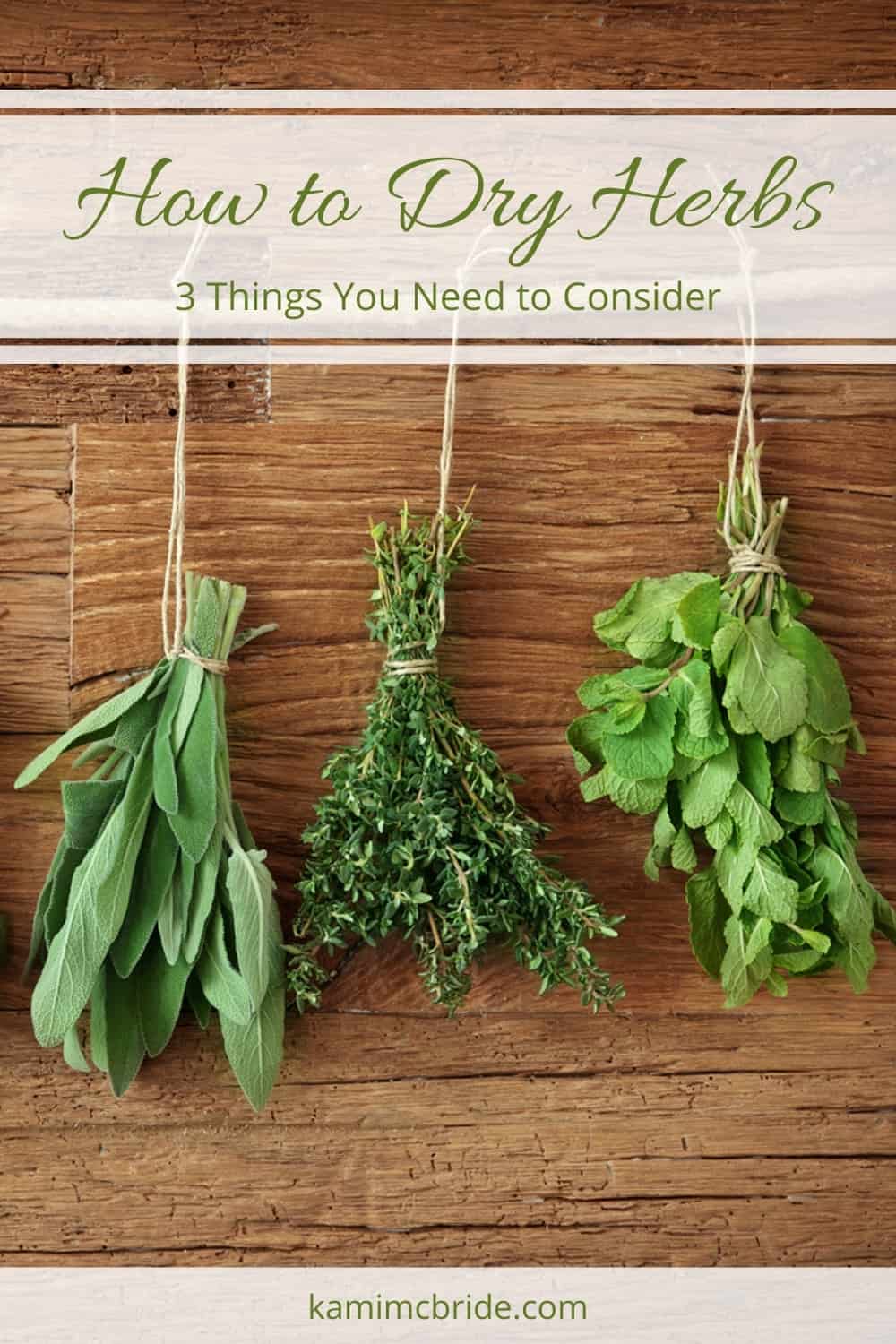

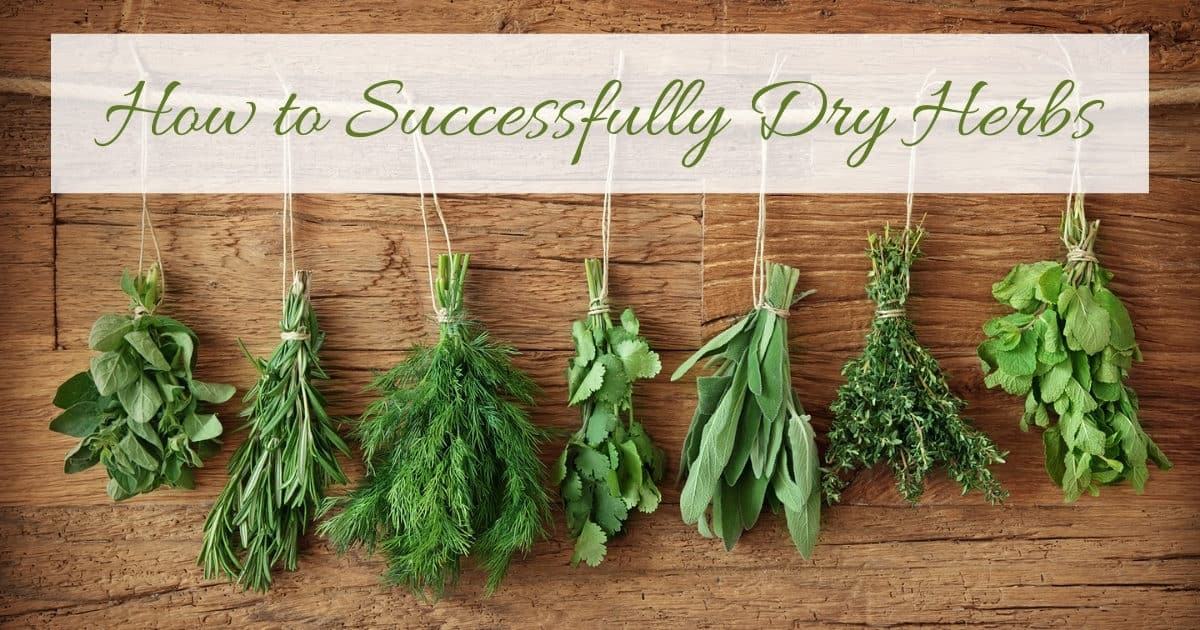

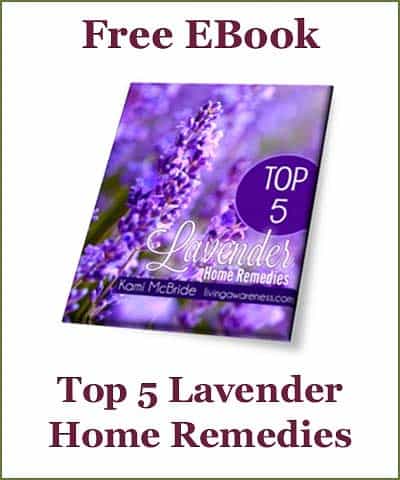

Always love & appreciate your teachings. I’m in southern Germany where summers are usually warm and relatively dry, but the climate is changing so that last summer was very wet and we’re now in drought conditions where usually we would have been more humid. So, as you said, I need to attend more to the actual conditions. I mostly lay out my herbs to dry, though sometimes I hang them in my pantry when it’s convenient and called for. I have no dehydrator, though I’ve been searching for one for some time now—I’m a bad shopper/consumer. What do you think… Read more »
I use the oven on pilot light or lowest setting only for things like citrus peel and roots.
For some herbs like goldenrod and yarrow, I hang in bundles from kitchen cabinets. For others, I use a dehydrator. For some reason, my mugwort can sit in the dehydrator for days and not get crunchy. I gave up and put them in a jar. They never molded, but are still soft and pliable.
I live in London UK and have found the best way is to hang my herbs to dry, this way they do not become mouldy. Alas, I am not always successful but I keep trying to see which works for me. Your blogs and videos are always inspirational to me
Thanks for this great video, I am so grateful for all your lessons Kami. I live coastal with a hot and humid climate in summer and wet/damp climate in winter. I have only just started drying my own herbs when we moved to a new house with a hot water cupboard. I figured drying the herbs in there is the safest spot all year round. Any tips, ideas, things to consider when drying in a hot water cupboard?
I don’t know if that would be a fire hazard or not. If you can hang your herbs in a dry environment safely, then that works.
Good Morning Kami, I have bee growing, drying and foraging herbs for many years. I used to use paper bags but did not like the end result. Then I tried a small electric dehydrator and that was ok for some herbs but cooked others like sweet basil to ash almost. So eventually I was living in a semi dessert area and decided to build my own dryer. It ended up 2’x2’x4′ covered with dark green cloth. That was about 18 years ago. I still use it even though we have moved to a totally different climate I can dry any… Read more »
I have dried herbs for years. When I was living in Montana I would dry them in the house or in the second floor of the garage.
I live in Louisiana and it is so humid here it is like a sauna. I had tried hanging my herbs to dry for several years but was always disappointed by the results. so this year i just decided to do it in a dehydrator. But i will do some hanging to dry in my house as an experiment.
Thank you for this clear and foundational video! It is so true that paying attention to each factor and recognizing each herb is the way to obtain desired results!
I have been drying my herbs both hanging and laying on my cookie rack since I no longer have my dehydrator. Sad story there, while I was at work one day my husband decided to de-pack rat me, thinking I would no longer be needing it or the ice cream maker and took it to the Goodwill store near us. Needless to say, he is no longer aloud in my craft room. They turn out pretty well. But depending on the weather (I live in North Idaho) it may take a couple days to dry out completely.
Thank you !! It’s fun to learn more ideas for doing something. Good job.!!
I live in the Pacific NW. I have dried using all three methods. I use a dehydrator more depending on our weather.
Hi Kami,
How do I keep my lavender from drying out too much? What should I store the dried bunches and/or buds in to keep them from being too crunchy!?
Marci
I use glass jars to store my dried herbs.
I should have been more clear. I grow lavender…about 22″ long, and am wondering about the best storage for the buds and dried bundles. Any suggestions?
Also, when making lavender oil, can I make bigger batches, like in a quart jar?
Thanks, I love your information and classes!
I share the bundles within a few days and, yes, I make larger batches in quart-size jars on occasion.
I’ve used lunch size paper bags, with several holes punched in them, placed my herbs inside and hung the bags on a string to dry my herbs. I thought it would help keep household dust off the plant. Would love to know your opinion on this method.